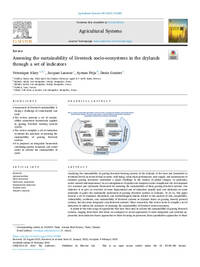Assessing the sustainability of livestock socio-ecosystems in the drylands through a set of indicators

Authors:
Analyzing the sustainability of grazing livestock farming systems in the drylands at the farm and household or territorial levels (in terms of food security, well-being, value chain performance, feed supply, and maintenance of common grazing resources) constitutes a major challenge in the context of global changes. In particular, social–natural interdependency in an entanglement of spatial and temporal scales complicates the development of a common and systematic framework for assessing the sustainability of these grazing livestock systems. Our objective is to give an overview of some fundamental sets of indicators usually used and elaborate on some principles to guide the sustainable assessment of grazing livestock systems in drylands. To do so, this paper reviews a set of empirical, theoretical, and methodological studies related to the analysis of risk, adaptability, vulnerability, resilience, and sustainability of livestock systems in drylands based on grazing (mostly pastoral systems, but also some integrated crop-livestock systems). More concretely, this review seeks to compile a set of indicators to inform the processes of assessing the sustainability of livestock socio-ecosystems.
It points to the wide range of approaches that have been used to address the sustainability of grazing livestock systems, ranging from those that focus on ecological or social approaches to more integrated and systemic approaches; from indicator-based approaches to those focusing on processes; from quantitative approaches to those that point out the need to take qualitative aspects into consideration; and from research-based assessments to participatory approaches. Based on this review, we propose a multi-scale indicators framework combining scales of space, time, and coordination to address the sustainability of these livestock systems. This framework aims to constitute a sound basis for elaborating a system of information that will contribute to and support policymakers and development agencies in developing their policies and measurements in order to ensure the sustainable development of pastoral and agropastoral systems in the short and medium-term. However, this study also warns about the multiple contextual scopes of the indicators and their implications, which reveal differing dynamics (and therefore adaptive capacities) of these systems.
